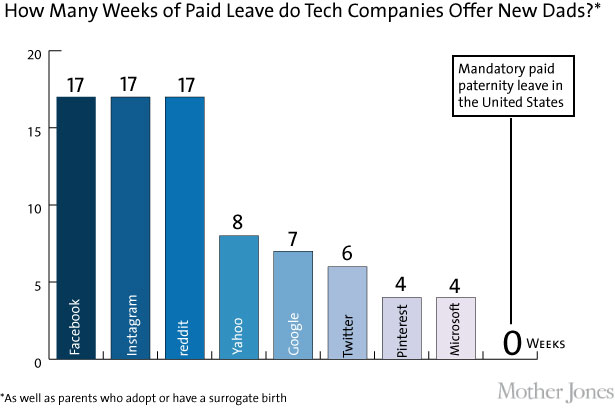You’re about to be a new dad, and you really want to be there for your child’s birth and, hopefully, for some time afterward. You know that spending some time with your child immediately after her or his birth to bond is priceless. You also know that being able to help your spouse care for your child and the household will be much appreciated.
Even though your employer may provide for paternity leave, you feel a little uneasy about asking for it. Perhaps you think that because you’re not the one who physically gives birth, your employer might wonder why you need to take time off from work due to the birth of your child. Or maybe you’re anxious because you think your boss might wonder why a man has to help take care of a child, since your boss feels that’s traditionally a “woman’s role.”
No matter the reason for feeling uncomfortable in asking for paternity leave, asking for it can create fear and uncertainty about your job security and/or your future career, among other things.
The following article will give a brief background about the status of paternity leave in the United States as well as provide some tips that will hopefully make your paternity request go smoothly and be more likely to be granted.
Table of Contents
ToggleState of Paternity Leave in the United States
Currently, no federal law requires paid paternity leave. Assuming the father qualifies, he is entitled to a certain amount of unpaid leave under the Family and Medical Leave Act (FMLA). Under the FMLA, a father is eligible for up to 12 weeks of unpaid leave during the course of a 12-month period to take care of his newborn child. More information, such as eligibility for FMLA leave, can be found in our recent blog post, “Can a Man Be the Victim of Family Responsibilities Discrimination?”
Some states do provide for paid paternity leave. For example, California and New Jersey offer six weeks of paid leave to new parents. However, the paid leave only provides a portion of the father’s actual income when leave is taken. Additionally, California doesn’t offer job protection like the FMLA does. Rhode Island and Washington State also provide partially paid leave for new dads to bond with their child, although only for four and five weeks, respectively.
Companies, especially tech based companies, tend to offer longer lengths of paid paternity leave. See the graph below:
Source: http://www.motherjones.com/politics/2013/05/silicon-valley-maternity-leave-paternity-leave
Unfortunately, many current and expecting dads don’t get such generous benefits from their employers. In fact, only 15 percent of employers offer any amount of paid paternity leave, according to the Society for Human Resource Management’s “2013 Employer Benefits Research Report.” Whether you work at a company that provides 17 weeks of paid paternity leave or a company that dreads giving just one day of unpaid leave for a serious illness, the tips below can help with the paternity leave request process.
- Know your employer’s policy for taking paternity leave. It helps to know exactly what your employer provides (or doesn’t provide) before you send a request letter or step into your supervisor’s office.
- Before asking for paternity leave, know how much leave you would like and how much leave you need. For example, if there are complications during delivery, your wife may need your help to care for her and your child. So in addition to using leave to spend time bonding with your child, you will need to care for your recovering wife. Assuming it takes six weeks for your wife to recover, it would be fair to say at least six weeks is necessary, while anything more than that is arguably (at least from your employer’s point of view) a bonus.
- Don’t wait too long to ask for leave. The FMLA requires that leave be requested at least 30 days in advance, unless a certain event, such as the birth of a child, necessitates the leave begin in less than 30 days. However, in this exception to the 30-day rule, the notice for leave must be provided as soon “as is practicable.”
- Explain how you are taking steps to minimize any disruption your absence will bring. Even if your employer’s policy allows you to take a given amount of paid or unpaid leave, don’t forget that your request may be putting your employer or co-workers in a tough spot. Show that you’re doing what you can to make things easier for your employer and co-workers. For example, explain how you have worked ahead on your tasks, arranged to have co-workers cover appointments or assignments for you, etc. Tell your supervisor that you have taken steps to make your absence seamless.
- Don’t be too greedy when asking for leave. Put another way, know when it hurts to ask. For example, if your company provides four weeks of paid leave and you only want two, depending on your work situation, just ask for two. Even if you could get those extra two weeks of unpaid leave, will asking for it give the wrong impression? Will it cause increased stress on your co-workers or boss and possibly lead to resentment?
- Be prepared for your request to be refused, legally or not. Furthermore, be prepared for your boss to be annoyed with your request. It may not be fair, but there are bosses who hate children or who are sexist.
- Be prepared to suggest alternatives. If your request is denied or if you’re not given the amount or type of leave you want, offer alternatives, such as working from home, working part time, or using accrued vacation/sick days.
Summing It Up
- Federal law does not mandate paid paternity leave, although a few states like California, New Jersey, Washington State, and Rhode Island, provide for partial income compensation to eligible employees for taking time off from work to care for newborn child.
- Federal law does require employers to provide unpaid leave to care for a newborn child, assuming the employee is eligible.
- Only 15 percent of companies provide any paid paternity leave, with tech companies leading the way in terms of providing paid paternity leave and the amount provided.
- When asking for paternity leave from your employer, take the following steps:
- Know your employer’s policy for taking paternity family leave.
- Know how much leave you would like and how much leave you need.
- Don’t wait too long to ask for leave.
- Explain how you are taking steps to minimize any disruption your absence will bring.
- Don’t be too greedy when asking for leave.
- Be prepared for your request to be refused.
- If your request is denied or you’re not given the amount or type of leave you want, offer alternatives.






